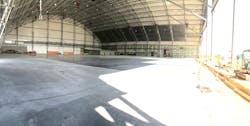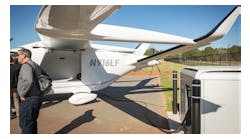When the new AAR MRO facility at Chicago Rockford International Airport (RFD) opened in 2016, a new era began, which could impact the region’s economy for years to come.
The MRO boasts about 200,000 square feet of space, the latest in fire protection and technology, and enough room to service wide body aircraft. While airport leaders understood the potential it can have on the area, it took a coalition of entities to make sure it was completed on time and on budget in a way that would work for everyone.
A Path for Growth
Jeff Polsean, economic development manager for the Greater Rockford Airport Authority said the airport has always tried to build its cargo operations. However, one of the issues leaders kept running into was concerns about aircraft landing at Rockford needing mechanical issue repaired.
Airport Director Mike Dunn went out to look for an MRO to handle aircraft repair and AAR was interested in established a facility at Rockford, but it needed a good supply of mechanics.
Rock Valley College, had an A&P program located at the airport, but was only graduating 15 to 20 A&P mechanics per year, Polsean said. After examining their options, the college committed to building a 40,000 square foot facility and start graduating 100 to 125 mechanics per year.
“Once that was in place, AAR was committed to the airport and starting an MRO operation, but what they needed was a hangar system in order to be able to do that process,” he said.
Polsean said Dunn was then able to work with local, state and federal entities to come up with the $41 million needed to build the MRO facility.
Construction began in July 2015 and the entire project was completed a little more than a year after it started.
Cheryle Jackson, president of AAR Africa, who was vice president of government affairs for the company when the project took hold, said the MRO in Rockford is very important because of its technology and position to service the latest aircraft and wide body aircraft.
“Rockford is important to the MRO industry nationally and it’s important to AAR,” she said. “And we know that it’s important to Rockford. It’s an important job creator, not just any jobs, but good paying, skilled jobs that don’t necessarily require a college education.”
Keeping It on Track
Polsean said the project faced challenges in creating the infrastructure for the facility, the supply chain and creating funding.
“Director Dunn led the charge as was able to bring all the parties to the table and come to an agreement as they went through the process and those challenges were all met,” he said.
Getting local federal and state entities to keep the financing in place is one challenge to the project; they also needed to keep all of the suppliers and consultants working together as well.
Sean Hickey, sales consultant for Rubb Building Systems, said Rockford airport officials first approached the company a few years ago at a tradeshow when they expressed interest in building some hangars. By 2014, the company was contacted by the airport again and brought in to show some of its options for the MRO hangar compared to other types of building technologies.
Because the company creates a different style of building that some designers and airport leaders are accustomed to, Hickey, said they kept educating project stakeholders about the usage of the Rubb building across the U.S. and how they work.
In the northern Illinois region, there’s plenty of concerns about harsh weather, Hickey said, so Rubb had to temper concerns leaders in the project and prove it would be able to handle the conditions the MRO facility would be subject to.
“We had to prove that our technology has worked elsewhere because we’re kind of seen as an alternative or kind of a new type of technology, so naturally people are always a little bit hesitant about something new,” he said. “We kind of had to prove from the ground-level up that we’ve done this before, the technology works, the fabrics are designed to be architectural fabrics and put on buildings and…these are durable, engineered fabrics that are made to be made to be put on buildings and weathered long-term.”
Hickey said Rubb also engaged stakeholders in the engineering details behind the building. Rockford hired an architecture and engineering firm for the project, so the company made sure to work with them on the specs to build it properly and create a strong cost estimate.
They also addressed any concerns project leaders had with the structure using quantifiable data, such as meeting fire code standards and foundation analysis.
Rubb also has to work the structure through energy code, which Hickey said is trickier because it varies quite a bit from state-to-state due to different climates and building codes. Getting the insulated roof approved meant showing studies Rubb performed on heat loss and air seal and air loss.
Hickey said Rubb was kept in the loop on the political challenges hitting the project externally and communication by the stakeholders was key in helping the company help do its part to move the MRO facility forward.
Jackson said the entire project came about because Dunn is “very determined and passionate,” and pitched AAR numerous times on getting AAR to establish an MRO at RFD. While the company is asked all the time about creating a new MRO, the difference with Rockford was the passion and vison Dunn showed coupled with the support of the city and the federal support.
Jackson said AAR laid out its infrastructure needs with a new facility to leaders so they had a clear idea of costs. The company also voiced its needs for a deep labor pool.
“You can have a great facility, but if you don’t have a labor force that can perform the work, this is a labor intensive industry and if you don’t have the labor force to perform the work, then your potential to grow is constrained,” she said.
Polsean said the airport worked to make sure the entities of the project were all committed to the final goal of completion.
“This is the first facility that AAR has in their system that was actually built for them,” Polsean said. “Their other facilities that they’ve gone in, they’re leased, they’re purchased older facilities that were either military hangars or hangars from airline companies that had sold them.”
Polsean said the design team worked with AAR to make sure the facility was built for their needs and operations to help it compete in the MRO world.
The short timeframe of building such a facility was a challenge, Polsean said and having a longer construction window would’ve been helpful, but they were able to do it.
“With that being said, we came out with a facility that is there’s nothing like it in the country or in the world,” Polsean said.
From the budgeting aspect, Polsean said it’s important to work with the entities to make sure that everyone understands where the project is at.
“We were very fortunate to have partners that understood the impact to the community as well as the region and to the aerospace cluster,” he said. “We had those who stepped up to the plate in order to complete the funding process that we needed.”
Communication was crucial for the vendor. Hickey said it’s important the partners are transparent about what’s going on and it needs to happen in an expedient manner.
“We had heard about it, we talked to the whole Rockford team including their legal team at Hinshaw (& Culbertson) they were very upfront with us about what was going on, I’d even say proactive at times in terms of communicating to use what was going on,” Hickey said. “We felt more like a partner on the project than just a vendor, or a low man on the totem pole in the project.”
Jackson said the local government in Rockford and the airport have all been able to work together to make it happen.
“They not only did say what they said they were going to do, what their plans were, what their intentions were, what they wanted to do, they actually delivered on it,” she said. “They delivered on it beautifully, they delivered it on time and they delivered it on budget.”




